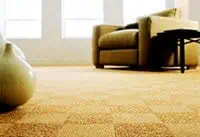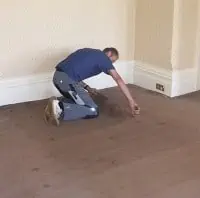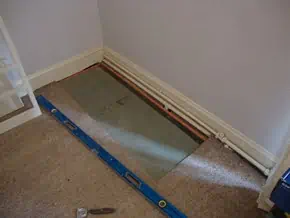A carpet fitter is someone who installs carpets, rugs, floors and floor coverings in public, private and commercial buildings
A carpet fitter is someone who lays a variety of different floor coverings inside a customer’s property.
The material being worked with can usually be fabric carpeting, laminate flooring, solid wood flooring, linoleum, natural stone tiles or “effect” overlays.
The term carpet fitter is sometimes used interchangeably with “floorlayer,” although the two jobs are quite different: carpet fitters install floor coverings, whilst floorlayers work with floor base materials.
The terms become more indistinct as many companies that install carpets also offer floorlaying services and package the two together under the banner of “floor installation.”
Salary
Candidates who wish to join established carpet fitting businesses can expect to earn £20,000 to £24,000 based on a 41-hour week.
Positions for newly recruited trainees with no experience tend to run below this figure for the first two years.
There is the possibility for regular overtime too, and also the occasional cash tip from customers.
This salary is based on aggregated searches of UK job opportunity web sites, and is reflective of fitters working in the South East of England but outside London.
Many fitters choose to become self-employed, and may subsequently seek to take on at least one additional worker.
It is a competitive industry in terms of new business starts, with many new entrants in locations around the UK.
Word-of-mouth advertising works to the benefit of established firms, and the earnings capacity for a successful business with a stacked commercial order book is theoretically uncapped.
Some firms struggle for revenue in areas where there is an outwards migration of other businesses due to recessionary pressures or declining demand.
Responsibilities
- Arrive at customer’s site at the designated time and place
- Work either on own or part of a fitting team to lay the carpet or chosen flooring material
- Leave the customer’s property in a tidy state with no reasons for customer “come-back”
- Ensure there are no exposed staples and grip rods, as these are potentially hazardous to the end user
- Partake in evening and weekend overtime in order to satisfy a busy order book of open work
- In the case of a self-employed candidate, the business owner must handle invoicing, tax and administration, at least on a day-to-day basis
- Self-employed candidates will also need to market their own business and find ways of attracting new customers
Qualifications
Most fitters have no formal qualifications as they are generally not required at the time of job application within this industry.
Some employers like candidates to have at least a GCSE standard in English and maths as this shows a general aptitude for communication and problem-solving.

Skills
- Candidates must be able to cut, lay and fasten carpets and floor coverings
- Must be able to measure accurately and advise on possible solutions to the customer’s requirements
- Must be able to work within a team of fitters in larger projects
- It may be a requirement that the fitter also drive the company van from site to site
- Good general people skills are necessary as the fitter will be working in close proximity to the customer
- A good appreciation in terms of being able to leave the site in a clean and habitable condition, even over multi-day installs
Working Conditions
Carpet fitting is a medium risk occupation due to the daily demands of cutting, gluing, pinning and fastening by way of a variety of tools used on site.
Risks of sharp objects entering the foot are negated by decent work boots, but there are times when the fitter will be working on site along with builders or electricians, so a degree of common sense is paramount.
This job challenges the candidate with the daily demands of heavy lifting, as anyone who has tried to move a rolled commercial overlay will testify.
Floorlaying remains a male-orientated industry with something of a “laddish” appeal, although some geographical areas have experienced significant changes in this respect; some prefer to work for small companies in a team of two, whereas other workers prefer the banter and teamwork found in larger workgroups.
Experience
New candidates can expect to receive training whilst on the job, and some firms use this as an excuse to pay a relatively smaller hourly rate.
However, experienced fitters can usually walk straight into a salaried role, depending on the advance order book of the company.
There may be an expectation that they train the younger members of the team too.
Career Progression
Many fitters who work for established floor installation firms decide to take the self-employed route, which has its pitfalls and perks common to most other industries.
Those who run their own business have to deal with taxation, managing workload, finding new jobs, sourcing stock, running vehicles and dealing with general accounting and faltering local markets.
Being a sole trader can be very stressful, but it affords the candidate the opportunity to brand and develop their own firm, and look to hire other fitters so that they may continue their expansion.
Employers
Carpet fitters usually work within a pre-defined geographical area for the simple reason that it is easier to build a local reputation than a national one.
Also known as…
- Floorlayer
Related Jobs
Image

What’s it really like?
James Jenkins is a carpet fitter at Tamar Solutions, which operates in the South-west of England.
James is a knowledgeable fitter with 28 years of first-hand experience in the local area.
What made you decide or choose to get into this sort of career?
It was a family business; my father was a carpet fitter also, and I saw that it was an honest way to provide a decent standard of living for myself and my family.
I’ve been doing this for almost 30 years now, so I guess you could say it’s part of my DNA now!
Do you have a standard day or a standard type of `exercise’?
Yes and no. The first part of a negotiation is the quote, so I need to visit the customer’s site and size up the job.
I can then discuss with the customer what they are looking for in terms of their requirements.
Felt or foam-backed carpet is the cheapest option, and some customers just want a good-looking job that is not expensive.
Vinyl is more expensive, and then the more premium carpets add XX-value on top.
My main areas for business include Saltash, Torpoint, Cawsand and Kingsands, Rame Peninsula and Millbrook, Downderry and Seaton.
I know the local area very well and have a lot of repeat trade from these districts.
What do you like most about the job?
I love where I live, as the South-west of England is a beautiful part of the world.
My job means I am out and about every day.
The main areas I cover are Plymouth, South-west Devon, and South-east Cornwall so even travelling to the jobs is a pleasure.
I take a huge amount of satisfaction from a job well done.
My motto is, “I like to gain satisfaction by working to your satisfaction.”
I think customers really appreciate this, and then they are more likely to recommend you to their friends or use you again in the future.
What do you like least about the job?
Moving furniture is the only real occupational hazard of my job.
Some of the antique furniture I have to work around and move is a real pain.
I work on my own for pretty much all of my time too, so there are times when I could do with a hand.
I try to do my own accounting but in busy times, it can be quite frustrating when you want to be out pricing new jobs.
With some of the larger commercial jobs (I don’t do many, to be honest), they can be quite intensive in terms of fitting hours on site, so early starts and late finishing is the order of the day!
If you enjoy what you do though, it’s not really a hardship.
What are the key responsibilities?
Making sure the customer gets exactly what they need, regardless of the material or finish.
As an experienced carpet fitter, I work with all sorts of materials including foam, hessian, jute and felt backed carpets, as well as vinyl sheet and tiles.
The main thing for me is to be attentive to detail and make sure my finished work looks clean and professional.
This is the difference between a good fitter and a “shoddy job.”
What advice do you have for someone who is looking to get into this as a career?
Just to know your local area and make sure you can get started with enough trade to keep you ticking over, even when the work dries up.
Things have been quite tricky since the recession of 2008 because people have been delaying spending money on non-essentials, and one of those non-essentials is home improvements.
Things are improving nicely, and my business is now doing well again.
It’s just something to be aware of, and it always pays to have something else to fall back on when things do not go to plan.









